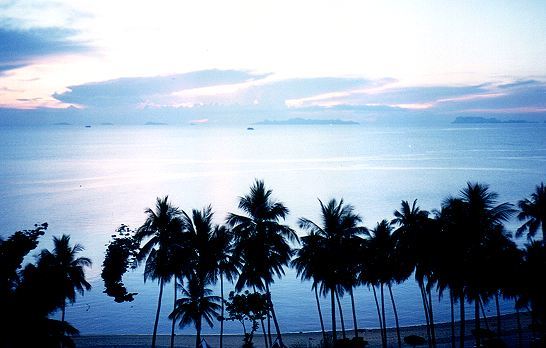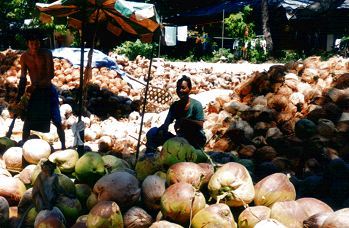

Info Ko samui
Denne sjarmerende lille øya ligger i Siambukta, og har de siste 10 årene vært gjenstand for en økende oppmerksomhet og utbygging. Den lille øya er bare 247 km2 og har ca. 35.000 innbyggere. Beliggenheten sørger for et fint og relativt jevnt klima og er derfor et populært reisemål året rundt. Det tar ca. to timer å kjøre rundt hele øya, og veien er nå asfaltert helt rundt. Koh Samui har en liten by ved fergeleiet i Na Thon, en tur dit kan være en hyggelig utflukt hvis du går lei av strandlivet. De mest utbygde strendene Chaweng og Lamai har sine tettsteder med restauranter og shopping, de mindre strendene har et og annet femstjerners hotell, ellers er det stort sett mindre hoteller og bungalower. Det er ikke mange severdigheter på øya. På nordvestsiden finnes det en stor og vakker Buddha statue, det finnes et par templer, du kan dra på tur til en kokosnøttplantasje og det finnes et vannfall og noen utsiktspunkter. Attraksjonene er først og fremst de vakre strendene som omkranser hele øya.
Å reise dit:
Lokal transport:
Shopping:
Hat Chaweng
– øyas lengste strand og også den mest utbygde stranden. I motsetning til Patong beach på Phuket, er bebyggelsen holdt i lav stil for å skåne miljøet på stranden. Man deler stranden i tre – nord, sentral og syd. I nord finner du de billige og enkle bungalowene og det er stille og fredelig både om dagen og kvelden. På den sentrale delen ligger det flere hoteller i mellomklassen, de fleste har beliggenhet mot sjøsiden. På veien bak ligger butikker, restauranter, diskoteker og vekslekontorer. Her finner du også dykkesentere og utleie av utstyr for alle typer vannsport, både med og uten motor. Skjermet av klipper i syd ligger Hat Chaweng Noi. Strandens eldste hotell ligger her, i tillegg til luksuriøse Imperial Samui hotell og et par mindre steder. Hat Lamai - Denne stranden ligger rett syd for Chaweng og var backpackernes strand for inntil få år siden. Nå er det imidlertid fullt utbygget også her.Templer & Severdigheter:

Palms on the west coast
The beautiful island is located in the deep south of Thailand, about 100 kilometers north ofKoh Phuket, but on the other side of the Isthmus of Kra, the narrow mountainous strip of land that connects Thailand and Malaysia. Koh Samui ("Koh" means "island") is only the most well known of a veritable archipelago of 80 islands in the south of the Gulf of Thailand (or Gulf of Siam, as it is still sometimes called). Among the other inhabitated island of the archipelago are Koh Phangan, which has approximately the same size as Samui and is located north of it (you can see it from Maenem Beach) and Koh Tao, also north of Samui island.
Most of the visitors to Samui Island come for swimming, sunbathing, or just doing nothing. The coral reefs around the island are, however, very good for snorkeling and scuba diving, and boating and fishing are also available (Samui is less suitable for wind surfing; the only two good beaches for it are Chaweng and Lamai).If you are not into marine sports then a little sightseeing may be interesting; Samui Island does not offer spectacular architecture or immortal monuments of art, but there are mountains, waterfalls, charming half-forgotten forest Wats (buddhist monasteries), and lovely little islands and islets around Koh Samui.
Hotels and Accomodation
It does not matter whether you are mainly interested in budget accomodation or looking for an international luxury hotel with all the frills - you can find both on the island. All over the island, in every little cove and on every little beach you can still find simple, very inexpensive bungalows. Most of the international hotels are located either on Chaweng Beach (a very long, extremely beautiful beach with powdery white sand and clean, crystal-clear water) or on Maenam Beach (yellow sand, but also nice, hotels: e.g. theParadise Beach). For instance, in Chaweng you find the Imperial and the Central Samui (both of them are first-class, the Central is the newest and has a very large landscaped hotel garden). Also noteworthy is the Princess Village on Chaweng which consists of twelve beautiful ancient Thai teakwood houses that were transported from Ayutthaya (the old capital of Thailand) to Samui and rebuilt here. (Inside, the bungalows are modern and offer all the necessary amenities like bathroom, air condition, etc.)
The best (and also most expensive) hotel on the island is theMeridien Royal Palm on the west coast. It has been built on cliff and offers spectacular views of the blue sea and the rocky little islets of the Ang Thong Marine Park.
Life on the island is still very quiet, much more so than for instance on Phuket. There are schools on Samui but the more well-to-do families prefer to send their children to the colleges and universities on the Thai mainland.

The main produce of the island are coconuts (which are processed for copra production), tropical fruit, and bamboo. Fishing is of course also a major source of income and recently the tourism industry (most of the accomodation offered on Samui is still owned by locals, not by large hotel chains) has become more and more popular.
For more info mail